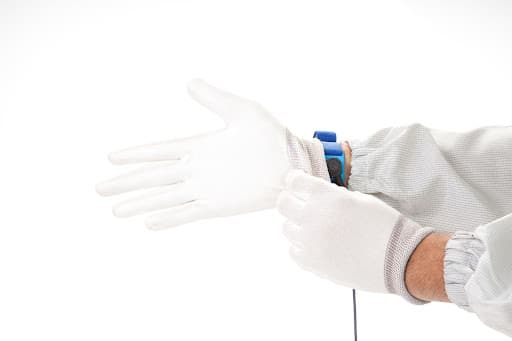There are a few options when you need to use gloves in your ESD protected area workplace. However, are dotted gloves better than the non-dotted variety? In this article we’ll discuss how ESD-safe gloves play an important role in an Electrostatic Discharge protected area. We will also uncover the various types of gloves, the dotted and undotted varieties, and their uses in the workplace.
Firstly, ESD is an acronym for Electrostatic Discharge. It is a discharge of static electricity that is potentially harmful for components or products in your manufacturing area if in direct contact. Provided that the worker is properly grounded to Earth, ESD-safe Gloves are created to dissipate electrostatic discharge and act as protective wear for the employees to shield the items they are handling. ESD coated palm gloves and ESD coated tip gloves are just a few examples of the ESD-safe gloves Bondline supplies.
ESD-safe Gloves are available in a variety of materials. As protective gloves, they are responsible for ensuring the EPA (ESD Protected Area) is kept up to the international standards set out in IEC-61340-1-5.
When the employees in the manufacturing area handle electrostatic sensitive materials they need to follow ESD grounding guidelines. There are several resources available to uphold the standards. You could choose to use ESD heel straps paired with ESD flooring, or other grounding methods such as an ESD wrist strap.
In all honesty, one or the other is not an option. There should be a variety of grounding options throughout the EPA as well provided for the persons to wear themselves. Components that are particularly sensitive to electrostatic discharge benefit from the use of ESD-safe gloves in conjunction with ESD heel straps, ESD-safe footwear, and ESD-safe wrist straps.

Generally you might be aware of one or two commonly used materials for gloves. Latex gloves are the most commonly used gloves across industries, think blue gloves in food manufacturing. You should be aware that not any general purpose glove provides electrostatic protection. They do however still provide resistance to scratches, fingerprints and other benefits associated with using gloves. The materials mostly used in ESD gloves are the following:
This material provides the only option for reusable gloves. This ESD glove option incorporates ESD protective material either as an addition to the entire construction of the fabric, added to the fingertips, or as carbon fibre stripes (as seen in ESD dotted gloves). Fabric ESD gloves are a cost effective solution, providing the ability to be used over and over and in between wash cycles. While they may be a costlier option compared to latex gloves, their longevity can save money in the long-term. Fabric ESD gloves are typically used for electronics, biotech and aerospace science applications.
Latex is one of the most commonly used materials for ESD gloves and anti static finger cots. It is the most cost effective solution as it is one of the less expensive materials used for ESD gloves. Unfortunately, latex allergies are common and need to be considered. While they are one of the most cost-effective options, latex gloves will need to be replaced regularly. Latex ESD gloves can be used for electronics, biotech, aerospace science, lab examination and general purpose applications.
This material is essentially an alternative to latex. However, vinyl is not nearly as durable as latex and is prone to breaking or developing holes. Though lose-fitting, vinyl gloves are very soft which provides good comfort. Vinyl ESD gloves are a good choice for electronics, biotech, aerospace science, lab examination and general purpose applications.
These ESD gloves are becoming increasingly popular as an alternative to latex, a more durable option to vinyl, and a convenient disposable option rather than fabric ESD gloves. Nitrile gloves offer a greater resistance to certain chemicals and higher tensile strength which makes the glove more hard-wearing. For those who are allergic to latex or prone to irritations, nitrile gloves are a safer option to use. However, they tend to be more expensive due to their enhanced properties. These gloves are suitable for electronics, biotech, aerospace science, lab examination and general purpose applications.
When you are faced with the many options of ESD gloves, you will need to take in consideration a number of factors when choosing what type of ESD-safe glove to use for your workplace.
Although at Bondline we do not specifically provide blue dotted ESD gloves, or blue gloves in general, the ESD dotted gloves we do provide are ESD Gloves with Dotted Palms. These are created to conform to the international standards set out by IEC 61340-5-1 as well being RoHS compliant and REACH compliant.
Knowing this, what is the purpose of dots on ESD gloves? The primary purpose of any glove with PVC dots is to provide safer use of components and items while wearing the gloves. The dots provide a grip for the user, one that you might not experience with traditional fabric based gloves. The grip that you might take for granted with the rubber as latex gloves. While there are blue dotting gloves, most dotted gloves tend to be white or grey as standard.
Therefore, the safe handling of electronic devices and components is optimised when your ESD-safe gloves also have PVC dots. Bondline’s dotted palm ESD gloves have a line of PVC dots down each finger and along the palm. Combined with a polyester lint-free fabric, these gloves give a surface resistivity of 10^(6) – 10^(9) ohms/square. As an added cost saving convenience, these gloves are washable and provide ESD protection even after 100 washes.
When used alongside other ESD protective personal wear, ESD gloves are necessary in EPAs to ensure the absolute ESD protection of each and every component that is being handled.
The benefits of ESD Dotted Gloves:
As mentioned above there are several factors to consider when choosing ESD gloves for your business. If you are still unsure once you have thought-out all considerations, or you’d like to ensure you choose the correct glove for your industry then contact any member of our team for clarification.
We also offer an audit to establish which of our ESD glove products are best suited for your business. In addition to this, we also run through the basics of how to use ESD-safe gloves with you and your employees. This is part of our ESD training and important for the use and longevity of the gloves (saving you time and money) and the ESD sensitive components you handle.
For more information or support, please contact us by filling the form below or calling us on +44 (0)1793 511000.
Fields marked with an * are required
On selected products if ordered before 1pm
Dedicated account manager to help your ordering process
Great value on premium quality products
Bondline Electronics Ltd are a leading manufacturer and supplier of static control products within the ESD industry. Products such as Flexible and Rigid Packaging, Bench Matting, Wrist Straps, Heel Grounders and Shoes, ESD Protective Clothing and Gloves, Test and Measurement Equipment along with many storage and handling solutions.
Bondline products are all qualified and compliant according to IEC-61340-5-1 International Standard.
Registered Company Number: 02933918
Office Hours: Mon – Thurs: 9am – 5pm Fri: 9am – 2pm

Bondline Electronics Ltd are a leading manufacturer and supplier of static control products within the ESD industry. Products such as Flexible and Rigid Packaging, Bench Matting, Wrist Straps, Heel Grounders and Shoes, ESD Protective Clothing and Gloves, Test and Measurement Equipment along with many storage and handling solutions.
Some of these cookies are essential, while others help us to improve your experience by providing insights into how the site is being used.
For more information and to read more about our privacy policy, please visit our Privacy Policy
Necessary cookies enable core functionality. The website cannot function properly without these cookies, and can only be disabled by changing your browser preferences.